Trees are vital to our landscape, providing beauty and welcome shade. They also offer environmental benefits, such as cleaning the air and reducing energy costs when placed near our homes. Many trees have other bonuses, such as colorful flowers, delicious fruit and nuts, and in some cases acting as a natural playground for our children.
With the benefits trees provide, it may be time for you to add one to your landscape. However, before you set out for the tree nursery, let’s look at the best time to plant a tree and how to do it the right way.
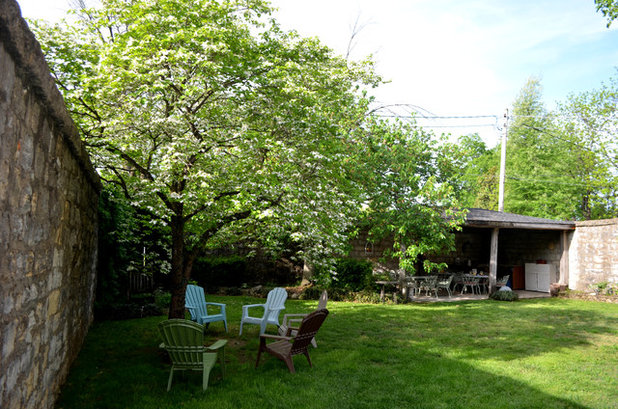
Noelle Johnson Landscape Consulting
Why You Should Plant a TreeAdding a tree to your garden is an important decision that shouldn’t be taken lightly. Before you buy one, take the time to ask yourself why you want one.
We know that trees are great for boosting curb appeal, but there are other ways to use them in the home landscape. A tree can provide welcome shade to a window or patio that receives afternoon sun, which also will help lower your energy bill. A tree with colorful flowers or foliage is a great way to add interest to a landscape in need of color. And a tree can screen an unattractive view and muffle noise on a busy street.
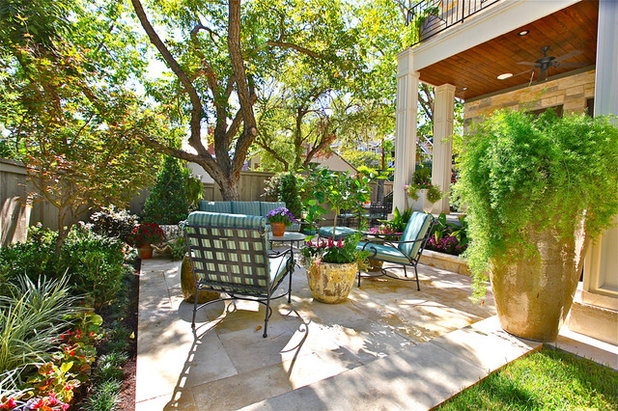
Pearson Landscape Services
Shown: A large tree provides shade to this seating area.
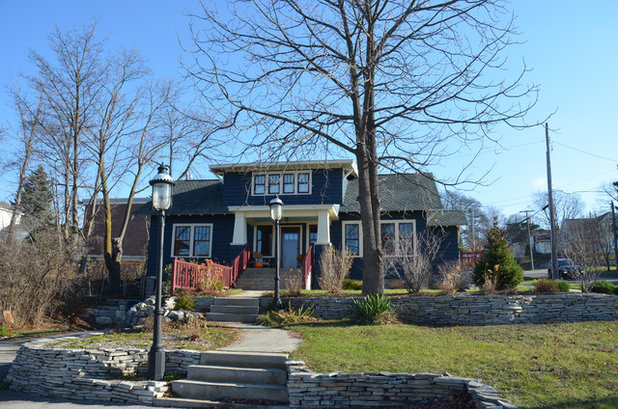
Noelle Johnson Landscape Consulting
Trees offer a wealth of environmental benefits.- Trees in the home landscape can save a household’s heating and cooling energy consumption by up to 25 percent, according to the U.S. Department of Energy.
- Trees clean the air by absorbing pollutants and carbon dioxide while producing oxygen.
- Trees provide shelter and food for wildlife.
- Trees can help save water by slowing evaporation from the plants growing in their shade.
Trees add tremendous aesthetic value. In addition to the color, height and texture trees offer, their branch architecture and attractive foliage help soften the edges of buildings, provide screening and frame attractive views. Trees not only add beauty to the landscape, but they also can increase property values up to 20 percent, according to statistics cited by the Arbor Day Foundation.
8 Reasons to Plant a Great Tree
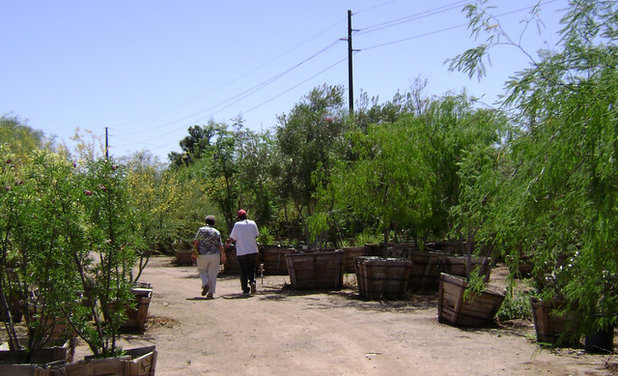
Noelle Johnson Landscape Consulting
How to Choose the Right TreeOnce you’ve decided why you’re planting a tree, it’s time to figure out what type will best fulfill your needs. Which benefits do you want from your tree?
- Energy savings. Select a large deciduous tree, which will shade your home spring through fall while allowing the sun to shine through in winter once its leaves have fallen.
- Shade. Choose a tree with a broad canopy (one with a growth habit that’s wide and not columnar) to maximize the amount of shade it produces. If you want shade year-round, select a tree that’s evergreen and won’t lose its leaves in winter.
- Color. Pick a tree with colorful foliage all year, such as a purple-leaf plum, or one that produces colorful flowers. Of course, you can always select a tree that puts on a vibrant fall display with its foliage.
- Fruit. Fruit trees do double duty by adding beauty with their attractive foliage and pretty spring flowers, and providing delicious fruit.
- Tidiness. It’s important to note that some trees are messier than others. If you’re planting a tree near a pool, select one that won’t produce messy flowers, seedpods or both. If possible, plant an evergreen tree near a water feature, pool or anywhere else you want to keep clean.
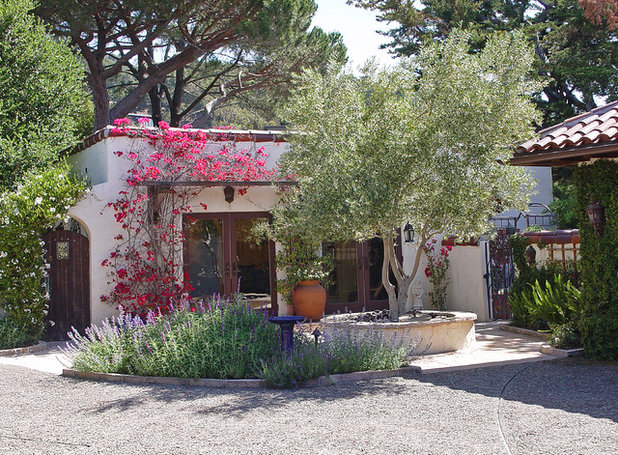
Simmonds & Associates, Inc.
Site checklist. Certain variables must be addressed before planting a tree.
- How much room do you have? This will make choosing a tree much easier, as it will eliminate ones that are too large or small.
- Are there any potential obstacles? Avoid power lines, nearby structures or utility lines running under the ground near the tree.
- Is there irrigation? Be sure that there’s a nearby water source, whether it’s an irrigation system or a hose.
Shown: An olive tree
(
Olea europaea) grows in a raised planter in this Mediterranean-style courtyard.
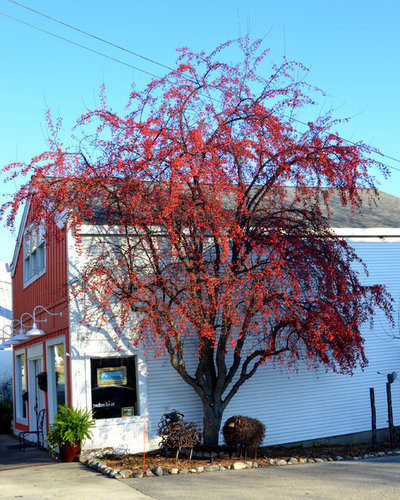
Noelle Johnson Landscape Consulting
When to Buy and Plant a TreeIt’s best to plant trees when they’re dormant. This occurs in fall after their leaves have dropped as well as in late winter or early spring just before the leaf buds begin to swell. Planting trees during this time gives their roots time to grow before warmer weather stimulates new top growth.
Of course, trees can be planted at any time of year, but extra care may be needed, such as making sure that they’re adequately watered during their first summer.
Shown: The red berries of possumhaw (
Ilex decidua) provide fall color.
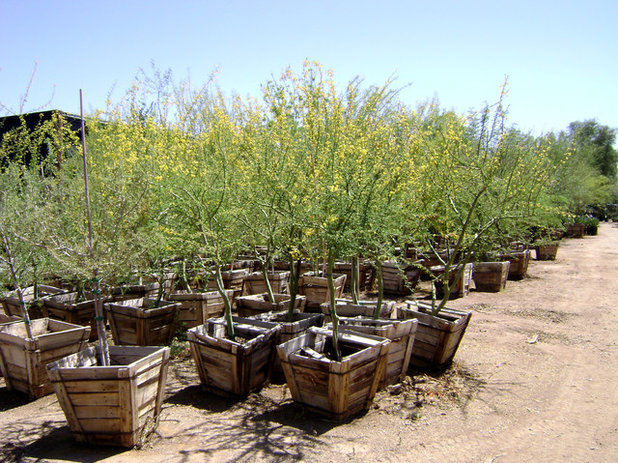
Noelle Johnson Landscape Consulting
When visiting your local tree nursery, you may see trees in different types of containers or some with no containers at all. Trees are contained in wooden boxes, plastic nursery containers, wrapped in burlap or other fabric and even wire. Bare-root trees have no container whatsoever.
The type of container doesn’t have much bearing on when to plant a tree except for bare-root trees, which can be planted only during late fall through early spring.
How to Buy Healthy Trees and Shrubs
Shown: Wooden boxes are filled with palo brea trees (
Parkinsonia praecox).
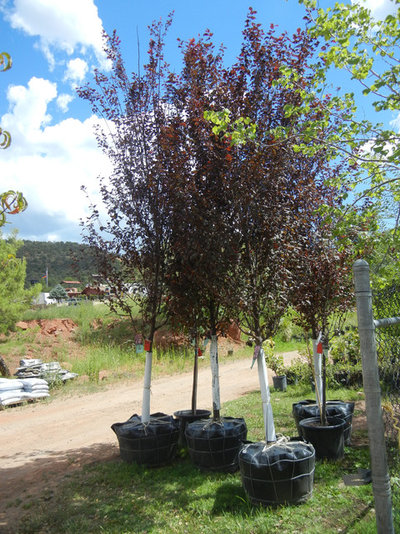
Noelle Johnson Landscape Consulting
This nursery’s purple-leaf plums (
Prunus cerasifera)
come in wire baskets.
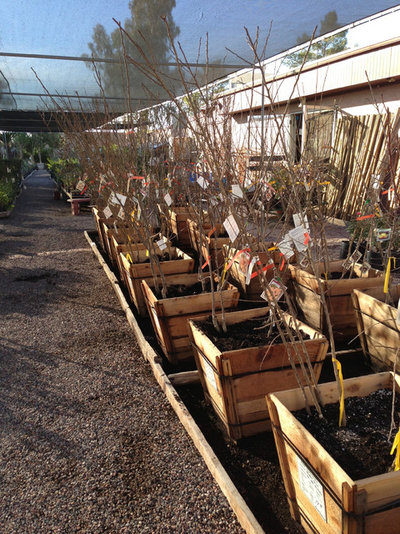
Noelle Johnson Landscape Consulting
Fruit trees’ bare roots stay moist in boxes filled with compost.
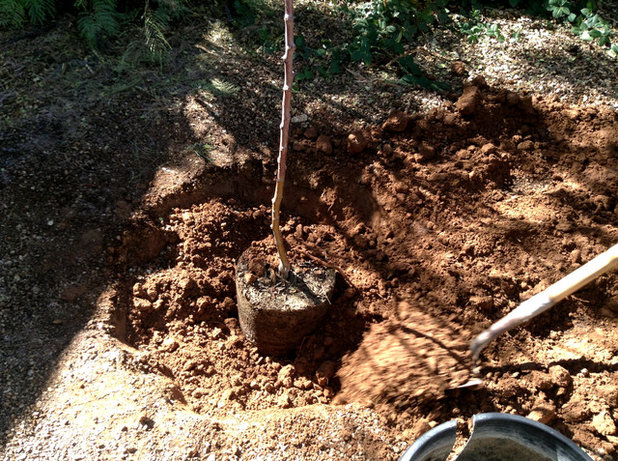
Noelle Johnson Landscape Consulting
How to Plant a Tree1. Get the hole right. The hole’s size plays a major role in how quickly a tree establishes itself and grows. Studies have shown that digging the right-size hole significantly increases a tree’s growth rate once planted.
The hole should be three times wider than the tree’s root ball and shaped like a saucer. This allows for good root growth and development, because the majority of a tree’s roots grow outward into the top foot of soil, where oxygen is at high levels.
The hole should be the same depth as the root ball, or even slightly shallower. Trees don’t like to be planted deeply because it decreases the amount of oxygen available to their roots. In addition, trees tend to settle a little lower after being planted.
If using an augur to create the planting hole, slightly scrape the edges of the hole to break up the “glazing” that augurs create, which can limit water movement and root penetration.
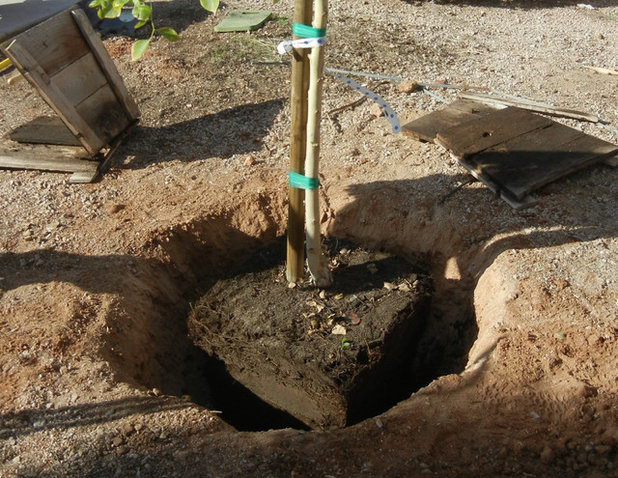
Noelle Johnson Landscape Consulting
This photo shows a hole that is the wrong size for the tree. It’s too narrow and a little too deep. Although the tree in this hole has grown, its growth rate has been slow compared with nearby trees planted in larger holes.
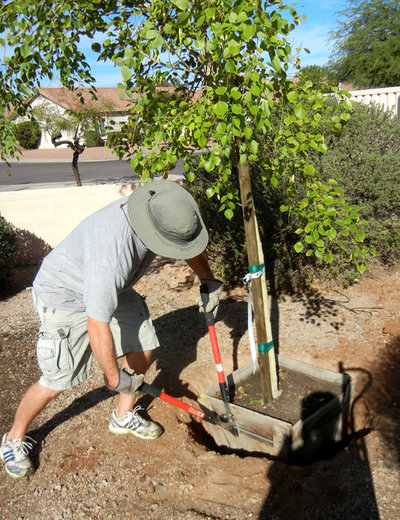
Noelle Johnson Landscape Consulting
2. Site the tree. Gently remove any excess soil on top of the root ball until you can see where the main roots begin to flare. Trees often come with a 2- to 3-inch layer of soil or mulch that covers the top of the root ball. This can limit the amount of oxygen available to the roots, especially after planting since trees tend to settle a few inches.
How you plant the tree depends on the material encasing the tree roots. For wooden boxes, place the tree in the hole while still in the box, and then take off the sides of the box. The bottom of the box should remain as it provides a solid base for the tree and won’t inhibit root growth, which occurs outward.
If your root ball is covered in burlap or other natural covering, place it in the hole before taking off the covering. Remove the covering down two-thirds of the way — it’s OK if the bottom is covered with the burlap. Synthetic coverings must be completely removed.
Place the tree in the center of the hole once it’s ready. (Be sure to measure the root ball and the hole to be sure the hole is the right size before you place the tree.) The tree’s root flare, where the large roots begin to flare out from the trunk, should be aboveground once it’s in the hole.
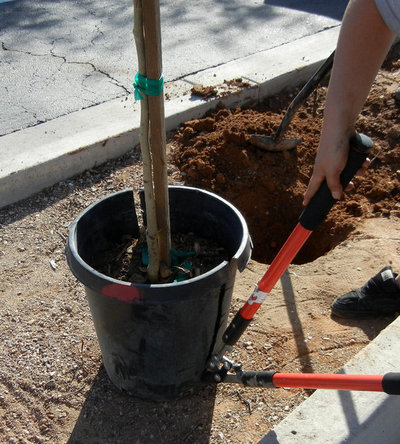
Noelle Johnson Landscape Consulting
Trees in plastic nursery containers can be planted by cutting away the container. This is best done by first laying the tree sideways on the ground and cutting away the bottom of the container with hand pruners or a utility knife. Place the tree in the hole and cut along the sides of the container in two areas, which will allow you to remove the rest of the plastic container. Avoid pulling a tree out of its container, which can damage its roots.
Whichever container the tree came in, it’s important to examine its roots once placed in the hole. If the roots are circling the root ball, there can be future problems with girdling that need to be addressed before planting. Using a pruning saw, remove the outer inch of soil all the way around. This will help break up the circling roots and cause them to grow outward.
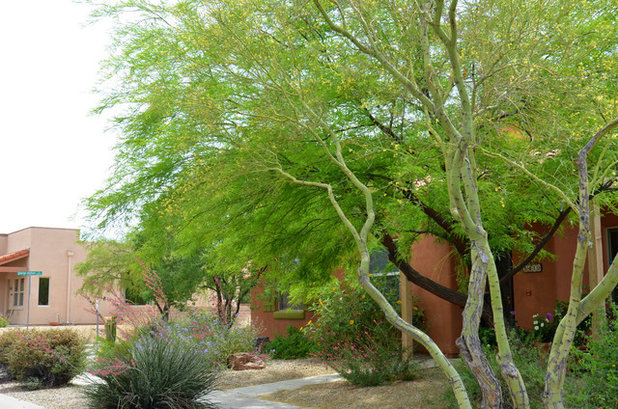
Noelle Johnson Landscape Consulting
3. Fill the hole. This step is the easiest one and consists of filling the hole with the same soil that you dug out to create the hole, called backfill. Add backfill to the hole around the tree, taking care to break apart any large chunks. After filling in the hole, create a berm around the hole, which will create a basin that will hold water to help it permeate deeply around the tree. Water immediately after planting to help settle the soil and get rid of air pockets.
No amendments are needed during planting and are, in fact, discouraged. Countless studies have shown that adding anything besides native soil can actually deter tree growth. The roots of trees planted in amended soil tend to stay within the original hole without venturing outward, which can stunt the growth of the tree. Additionally, trees planted with amended soil tend to hold on to too much water and have undue settling as the organic amendments decompose and lose volume over time.
Shown: A palo verde tree (
Parkinsonia sp.) creates an airy canopy.
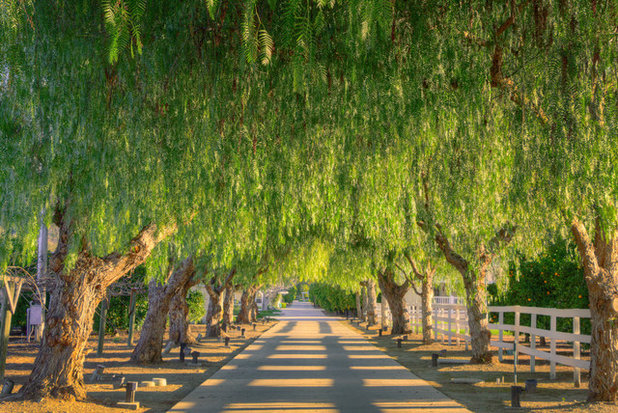
Peter D'Aprix Photography
4. Water and mulch. New trees will need more water for the first year to help them get established — especially during the first few weeks after planting. Often, homeowners overwater their new trees, causing the leaves to turn yellow and fall off. The frequency of watering can vary depending on your region, which makes your local cooperative extension office or the nursery where you bought your tree the best resources for a recommended watering schedule.
Add a 2- to 4-inch layer of mulch, such as shredded bark, compost or wood chips, around your new tree, covering the entire planting area. Keep the mulch 6 inches away from the trunk to prevent problems with fungal diseases or insects. Adding mulch will help moderate soil temperatures, keep down weeds and retain soil moisture. In addition, as the mulch breaks down, it improves the soil.
No fertilizer should be added to your tree for the first year. Fertilizer can burn young tree roots and stimulate excess leaf growth before the tree has enough roots to support it.
Shown: California pepper trees
(
Schinus molle) form a tunnel.





